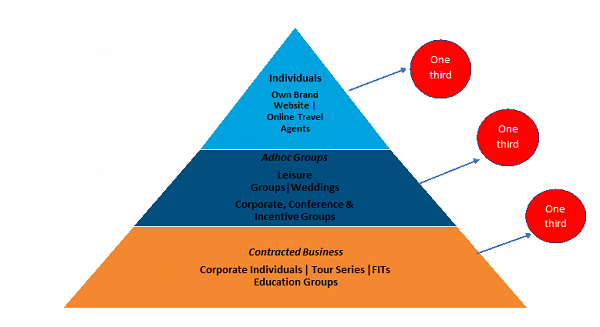Sales, Channels and Customer Segments
Contents
Achieving 52-week revenue generation across seasons
Sales, Channels and Customer Segments
Similarly, if the tourism business understands how to blend diverse sales channels and customer segments from diverse markets, it can create flexible revenue generation models to target the opportunities available across diverse seasons.
For example, in the model below, the tourism business chooses to build its revenue generation across three tiers as follows
1. Contracted Business: providing a revenue base at a lower negotiated price
2. Adhoc Group Business: providing higher priced adhoc leisure and corporate business
3. Individuals: filling the last rooms/spaces/ticket sales via direct and indirect sales channels
During periods of medium and high demand, this business might choose to sell approximately one third of its inventory across each of these tiers. Depending on the season, the business might adjust this formula for example by
- increasing the proportion of leisure business to compensate for a decrease in corporate individual business for its high summer season or by
- increasing the allocations allowed to online and offline travel agents during low and shoulder seasons to compensate for a reduction in demand
- using this model, the business might also use market insights to create opportunities by (for example) targeting leisure individual customers from the GB market in low and shoulder seasons
|
Tip - If the tourism business learns how to engage with diverse sales channels, customer segments and markets, it can blend opportunites to
|
Sample Revenue Generation Model for a Tourism Business- Blending Diverse Sales Channels and Customer Segments from Diverse Markets

CRM and Database Management
CRM and database management also plays an important role in the generation of year-round business. For example, a tourism business
- that records customer data (according to GDPR compliance) for loyal and repeat customers can use this data to issue targeted communications with (for example) special club rates to drive demand during low and shoulder seasons
- that records customer data according to special interests (such as golf, spa, dining etc.) can use this data to issue targeted communications to drive demand across relevant seasons
- that records customer data according to customer segment and market (for example ROI-families or GB-golfers) can issue targeted communications to drive demand across seasons when these markets and customer segments are known to travel
| Tip - By collating customer data, the tourism business places itself in a position of control so that it can communicate offers to loyal customers in order to drive demand when required. |